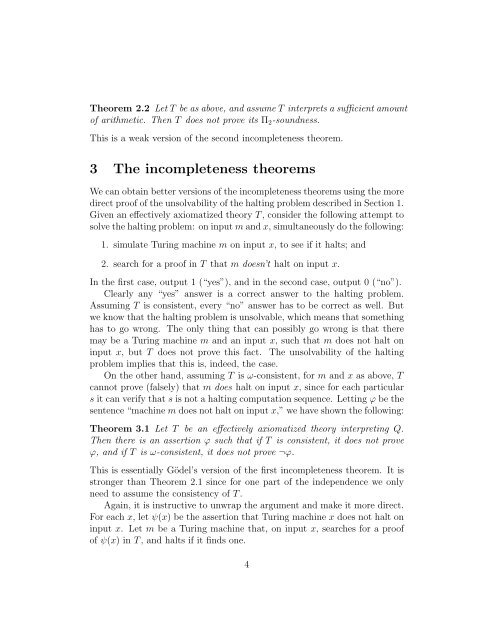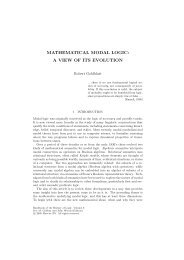Incompleteness via the halting problem
Incompleteness via the halting problem
Incompleteness via the halting problem
You also want an ePaper? Increase the reach of your titles
YUMPU automatically turns print PDFs into web optimized ePapers that Google loves.
Theorem 2.2 Let T be as above, and assume T interprets a sufficient amountof arithmetic. Then T does not prove its Π 2 -soundness.This is a weak version of <strong>the</strong> second incompleteness <strong>the</strong>orem.3 The incompleteness <strong>the</strong>oremsWe can obtain better versions of <strong>the</strong> incompleteness <strong>the</strong>orems using <strong>the</strong> moredirect proof of <strong>the</strong> unsolvability of <strong>the</strong> <strong>halting</strong> <strong>problem</strong> described in Section 1.Given an effectively axiomatized <strong>the</strong>ory T , consider <strong>the</strong> following attempt tosolve <strong>the</strong> <strong>halting</strong> <strong>problem</strong>: on input m and x, simultaneously do <strong>the</strong> following:1. simulate Turing machine m on input x, to see if it halts; and2. search for a proof in T that m doesn’t halt on input x.In <strong>the</strong> first case, output 1 (“yes”), and in <strong>the</strong> second case, output 0 (“no”).Clearly any “yes” answer is a correct answer to <strong>the</strong> <strong>halting</strong> <strong>problem</strong>.Assuming T is consistent, every “no” answer has to be correct as well. Butwe know that <strong>the</strong> <strong>halting</strong> <strong>problem</strong> is unsolvable, which means that somethinghas to go wrong. The only thing that can possibly go wrong is that <strong>the</strong>remay be a Turing machine m and an input x, such that m does not halt oninput x, but T does not prove this fact. The unsolvability of <strong>the</strong> <strong>halting</strong><strong>problem</strong> implies that this is, indeed, <strong>the</strong> case.On <strong>the</strong> o<strong>the</strong>r hand, assuming T is ω-consistent, for m and x as above, Tcannot prove (falsely) that m does halt on input x, since for each particulars it can verify that s is not a <strong>halting</strong> computation sequence. Letting ϕ be <strong>the</strong>sentence “machine m does not halt on input x,” we have shown <strong>the</strong> following:Theorem 3.1 Let T be an effectively axiomatized <strong>the</strong>ory interpreting Q.Then <strong>the</strong>re is an assertion ϕ such that if T is consistent, it does not proveϕ, and if T is ω-consistent, it does not prove ¬ϕ.This is essentially Gödel’s version of <strong>the</strong> first incompleteness <strong>the</strong>orem. It isstronger than Theorem 2.1 since for one part of <strong>the</strong> independence we onlyneed to assume <strong>the</strong> consistency of T .Again, it is instructive to unwrap <strong>the</strong> argument and make it more direct.For each x, let ψ(x) be <strong>the</strong> assertion that Turing machine x does not halt oninput x. Let m be a Turing machine that, on input x, searches for a proofof ψ(x) in T , and halts if it finds one.4
















